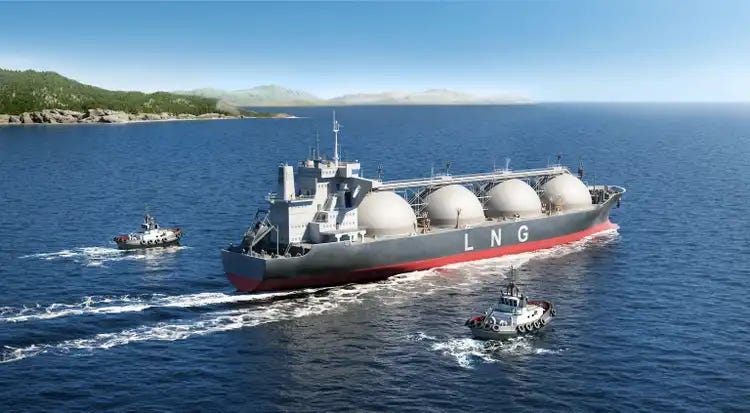CP2 LNG Approved: Louisiana Set to Host America’s Largest LNG Export Facility
By The Bayou Insider Staff
In a historic move for Louisiana’s energy sector, the Federal Energy Regulatory Commission (FERC) has granted final approval for Venture Global’s CP2 liquefied natural gas (LNG) export facility. With construction set to begin immediately, the $27–$28 billion project is poised to become the largest LNG export terminal in the United States—solidifying Louisiana’s place as a global energy hub.
🔧 A Massive Project with National Implications
The CP2 facility, located in Cameron Parish, will sit adjacent to Venture Global’s existing Calcasieu Pass terminal. Designed to have a nameplate capacity of 20 million metric tons per annum (MTPA) and a peak capacity of up to 28 MTPA, CP2 will dramatically expand U.S. LNG exports.
Supporting the terminal is the CP Express Pipeline, a 91-mile system capable of transporting 4 billion cubic feet of natural gas per day from East Texas and Southwest Louisiana. To speed up construction, Venture Global plans to use modular, prefabricated components—mirroring the approach that helped bring Calcasieu Pass online ahead of schedule.
🌿 Environmental Approval, But Not Without Controversy
FERC’s approval followed a supplemental Environmental Impact Statement (EIS), which evaluated the project’s potential air quality impacts. The EIS concluded that emissions—including nitrogen dioxide and particulate matter—would not have significant cumulative impacts on regional air quality, clearing a major hurdle for the project.
But not everyone agrees with the findings.
Environmental groups and local activists have voiced strong opposition, warning of possible long-term consequences for Louisiana’s already fragile coastal ecosystems. Concerns include:
Loss of coastal wetlands, crucial for storm protection and wildlife
Risks to fisheries and marine ecosystems
Disproportionate impact on low-income and minority communities
Groups like Earthjustice have filed legal challenges to the project's coastal use permits, and critics argue that the federal approval process does not go far enough to protect vulnerable populations and habitats.
📈 A Game-Changer for U.S. LNG Exports
The CP2 terminal is not just a local development—it’s a global play. Once operational, the facility will push Venture Global’s total export capacity to 66.5 MTPA, surpassing Cheniere Energy and establishing the company as the top LNG exporter in the United States.
The project has already secured long-term sales agreements with global energy giants such as:
ExxonMobil and Chevron
JERA and INPEX (Japan)
China Gas Holdings
Germany’s SEFE and EnBW
New Fortress Energy
These contracts reflect the high global demand for U.S. LNG, especially as Europe and Asia look to reduce dependence on Russian energy and secure stable, long-term supply chains.
🗣️ Community and Legal Pushback
While energy companies hail the project as an economic boon, local communities and coastal advocates remain skeptical. In addition to environmental concerns, residents fear negative health effects from industrial expansion—especially in communities already burdened by pollution and storm vulnerability.
The legal battle is intensifying, with Earthjustice and others challenging the validity of state-issued permits. They argue that CP2 could accelerate wetland loss, worsen flood risks, and threaten subsistence fishing traditions in one of Louisiana’s most environmentally sensitive regions.
Adding to the uncertainty, several major insurers have reportedly withdrawn or limited coverage for LNG projects in the Gulf region, citing increased financial risk from climate-related events and environmental liabilities. This trend signals a shifting landscape that could affect how future projects are financed and protected.
⚖️ Environmental Justice in Focus
The CP2 controversy has thrust environmental justice into the spotlight once again. Critics argue that the continued expansion of petrochemical and LNG infrastructure along the Gulf disproportionately affects historically underserved communities—many of whom have little political power or say in the planning process.
National and state leaders are now facing pressure to reform how energy projects are permitted, especially those near vulnerable populations. Questions loom over whether economic gains should outweigh the social and ecological costs borne by specific communities.
📍 Louisiana at a Crossroads
There’s no doubt: CP2 represents a monumental development for Louisiana’s economy and global energy strategy. But it also presents a test. Can the state pursue large-scale energy production while respecting its people and protecting its land?
With construction set to begin, that question becomes more urgent than ever.
As the world watches, Louisiana must decide how to balance progress with preservation, and how to ensure that the benefits of growth do not come at the cost of those who call its fragile coastlines home.
🔎 Get Involved
Explore the CP2 FERC Approval Documents
Attend local parish council and environmental hearings
Follow updates from environmental organizations and energy developers
Voice your concerns or support to Louisiana’s public officials
Final Reflection
With CP2 now approved and poised to redefine America’s LNG export landscape, all eyes are on Cameron Parish. Louisiana is once again proving that it can lead on the global energy stage—but whether that leadership can be sustained in the face of legal, environmental, and insurance challenges remains to be seen.
What happens here could shape not just the local economy, but the future of U.S. energy policy for decades to come.
⚙️ Have Your Say in Louisiana’s Energy Future
The CP2 LNG project is more than a business deal—it’s a turning point for our state. Whether you’re for it, against it, or still undecided, your voice matters.
👉 Stay informed by following FERC and DOE updates
👉 Attend local public meetings and permit hearings
👉 Connect with local leaders and environmental groups
👉 Share your thoughts with The Bayou Insider—submit a letter to the editor or comment on our Substack
The future of Louisiana’s coast, economy, and communities is being built now. Be part of the conversation.





